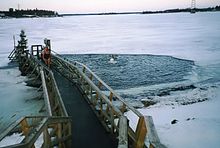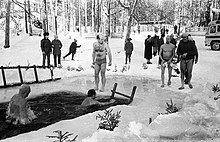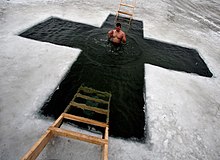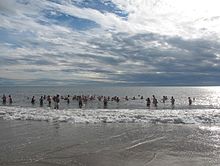| This article needs additional citations for verification. Please help improve this article by adding citations to reliable sources. Unsourced material may be challenged and removed. Find sources: "Winter swimming" – news · newspapers · books · scholar · JSTOR (January 2008) (Learn how and when to remove this message) |


Winter swimming is the activity of swimming during the winter season, typically in outdoor locations (open water swimming) or in unheated pools or lidos. In colder countries, it may be synonymous with ice swimming, when the water is frozen over. This requires either breaking the ice or entering where a spring prevents the formation of ice. It may also be simulated by a pool of water at 0 °C (32 °F), the temperature at which water freezes.
In Nordic countries of Europe as well in Eastern Europe (e.g. Ukraine, Russia, and Baltic countries), winter swimming is a traditional cultural element and part of religious celebrations like the Epiphany in Eastern Orthodoxy.
Competitions for winter swimming also exist. Many winter swimmers swim with standard swimsuits rather than with wetsuits or other thermal protection. Famous ice and winter swimmers include Lynne Cox and Lewis Gordon Pugh.
Also, many locations in North America and Europe hold polar bear plunges, commonly to celebrate New Year's Day, although participants are not expected to swim and generally most do not swim.
International winter and ice swimming competitions take place around the world with two of the larger organizing bodies being the International Ice Swimming Association and the International Winter Swimming Association. Both organizations have similar competition guidelines including water temperatures typically below 5 °C (41 °F), a 25 metres (82 ft) pool often cut out of frozen bodies of water, and swimmers limited to goggles, one standard bathing suit, and one latex or silicone cap - neoprene is not allowed.
Maintaining the hole in the ice
One way that the hole is maintained at regular ice swimming places is with a pump that forces the water to circulate under the hole, preventing ice from forming. Small ice-holes can also be kept open by keeping a lid/top over the hole to prevent ice forming.
Most ice swimming places also use a specific heated "carpet" going from the locker rooms to the ice-hole, both to make walking to the hole more pleasant and for safety as otherwise the water dripping from returning swimmers would freeze and create a dangerously slippery surface to walk on.
National traditions
Northern Europe

In Denmark, Estonia, Finland, Latvia, Lithuania, Norway, Russia and Sweden the ice swimming tradition has been connected with the sauna and Banya traditions. Unlike dousing, it is not seen as an ascetic or religious ritual, but a way to cool off rapidly after staying in a sauna and as a stress relief.
Ice swimming (avantouinti) on its own is especially popular in Estonia and Finland. There is an Avantouinti Society, and swimming holes are also maintained by other groups such as the Finnish skiing association (Suomen Latu). The Finnish Sauna Society maintains an avanto for sauna goers.
There are many places to swim without sauna in Finland during winter. Helsinki has several places for avantouinti, with dressing rooms and sometimes with saunas. There is also a number of ice swimming and winter sauna locations around Tampere.
Oceania
Australia
In New South Wales, the Bronte Splashers Winter Swimming Club claims to be the oldest Winter Swimming club in the world founded in 1921. It competes against Bondi Icebergs Winter Swimming Club, South Maroubra Dolphins Winter Swimming Club, Cronulla Polar Bears Winter Swimming Club, Maroubra Seals Winter Swimming Club, Coolangatta Surf Life Saving Club, Clovelly Eskimos Winter Swimming Club, Coogee Penguins Winter Swimming Club, Wollongong Whales and Cottesloe Crabs in the Winter Swimming Association of Australia Championships.
In Victoria, the Brighton Icebergers and the Shrinkäge swim group swim in Port Phillip Bay, the latter at Elwood Beach in Elwood
Western Europe
United Kingdom
Famous locations include the Serpentine Lake in Hyde Park, London, and Highgate Ponds in Hampstead. The largest fresh water pool in the UK is the Tooting Bec Lido in South West London which is home to the South London Swimming Club. The pool is 100 yards (91 m) in length, i.e. nearly twice as long as an Olympic pool. As the winter approaches and the water temperature drops then swimmers stay in for less and less time, swimming just one or two widths rather than several lengths. Races take place all year including on Christmas Day and New Year's Day.
The Middle Yeo Surf Life Saving Club hold the annual New Year's Day swim in Clevedon. It is usually held 20 minutes before high tide or if the times are not conducive to a large crowd the swim is held in Marine Lake. The Middle Yeo Surf Life Saving Club swim every weekend of the year and the forthcoming swim times are published in their alcove in Top Beach, Clevedon.
The Chester Frosties are an informal Facebook group of over 1,000 swimmers who swim all year around Cheshire, Lancashire, Wirral, Merseyside and North Wales. Local specialities include tidal bore and surge swimming on the River Dee.
Sheffield Outdoor Plungers are another informal Facebook group of 3,000 swimmers who swim in locations all over the Peak District and Sheffield area, and campaign for better access to waters.
Belgium
There are some clubs where people swim all year in a pool, a lake, or a river. Locations are Bruges, Boom, Deurne Dendermonde, Wachtebeek, Theux and Huy. The most famous race is across the Meuse each last Sunday of February since 1963.
Germany
The International Ice Swimming Association hosts an official ice swimming event at the Wöhrsee, a lake in Burghausen.
Switzerland
In Geneva the yearly Coupe de Noël is an event organized in December since 1934. Around 2,500 participants, many of them dressed up, swim 120 metres (390 ft) in Lake Geneva.
The Netherlands
In Scheveningen there is a yearly event known as the "Nieuwjaarsduik" or New year's dive in English. In which people swim in the freezing North sea. Participants range in the thousands.
Central Europe
Poland

The history of winter swimming (pływanie w zimie, also morsowanie, a loanword from Eastern European languages) in Poland dates back to at least 16th century, when Wojciech Oczko, the physician to the Kings Stephen Báthory and Sigismund III Vasa, published a treatise Cieplice, which contained the information on the contemporary understanding of water-based therapies, including the indications and contraindications to swimming in cold temperatures.
The oldest registered association for winter swimming enthusiasts, the Gdański Klub Morsów, was founded in 1975.
Eastern Europe and Russia

In Russia ice swimming may have been practiced since pagan times. During the times of Moscovian Russia swimming in ice holes was a popular tradition. Records are dating the tradition back to as early as 1525. It was also an important court ceremony and a folk custom in Tsardom of Russia.
In Russia and other Eastern European countries where Eastern Orthodox Christianity is the prevalent religion ice swimming is connected with the celebration of the Epiphany. The Epiphany is observed on 19 January according to the Julian calendar of the Russian Orthodox Church. The day marks the baptism of Jesus in the River Jordan. To celebrate this, holes are cut in the ice on rivers, lakes or other bodies of water, usually in the form of a Christian or Orthodox cross. Around midnight, believers submerge themselves three times in the water to honour the Holy Trinity, after a priest says a prayer.
Ice swimming on the Epiphany is relatively new. It was practised by only a few before the October Revolution of 1917 and occurred even less frequently in the time of the Soviet Union, when Christians were persecuted. However, the ritual became very popular in the 1990s since the Dissolution of the Soviet Union. In Moscow alone, 30,000 believers swam in ice holes in 37 fonts during the Epiphany of 2010. There is a popular belief that the practice erases a person's sins, but this is not endorsed by the Russian Orthodox Church. On the holiday in January 2020, 2 million people practised ice swimming in Russia for the baptism of Jesus.
Ice swimming is also practised during the entire winter by Walrus Clubs, whose members are called "walruses" (Russian: моржи, "morzhi"). In other Eastern European countries such as Bulgaria and Romania, the Epiphany is celebrated on 6 January. There it is tradition for Orthodox priests to cast wooden crosses in the water, which are then retrieved by the believers. It is popularly believed that the person who finds the cross is freed from evil spirits. Other countries where this is done include Serbia and Montenegro.
North America
The members of Canadian and American "polar bear clubs" go outdoor bathing or swimming in the middle of winter. In some areas, it is unusual or ceremonial enough to attract press coverage. "Polar bear plunges" are conducted as fund-raisers for charity, notably the Special Olympics, however these events do not actually involve swimming, but rather running into the water and back out again. Cosmo Kramer briefly joins a New York polar bears club in the sitcom Seinfeld.
The Russian immigrant professor Louis Sugarman of Little Falls, NY was the first American to become a famous ice swimmer in the 1890s. He attracted worldwide attention for his daily plunge in the Mohawk River, even when the thermometer hit −23 °F (−31 °C), earning him the nickname "the human polar bear".

The oldest ice swimming club in the United States is the Coney Island Polar Bear Club of Coney Island, New York, founded in 1903 by Bernarr MacFadden. The club organizes an annual polar plunge on New Year's Day as well as regular swims in the Atlantic Ocean every Sunday from November to April.
Asia
China
There are reportedly 141 winter swimming organisations across China with a membership of more than 200,000. The younger swimmers are under ten years of age and the older ones in their 80s. In Beijing, there are the winter swimming places such as Shichahai (什刹海), Yu Yuantan (玉渊潭) and Xihu swimming pool in Qinghua University, etc.
In Harbin, northern China, many ice swim in the Songhua River. Also Jinan is a place of annual winter swimming festival. The big event is swimming across Daming Lake about 300 metres (980 ft). In Taiyuan, where air temperature often goes below −10 °C (14 °F) in winter, hundreds of men and women ice swim each day in the Fen River.
In Dalian, a coastal city in northeast China, hundreds of people swim in the sea in winter. Most people choose to go to the beach at noon. Some of them are concentrated in several beaches in the city, such as Fujiazhuang beach, Xinghai Square beach and Shicao beach. At Bangchuidao Island beach, there are also some swimmers who choose to go swimming in the sea before sunrise.
Jinan is also the site of annual Chinese national winter swimming festivals since 2014, as an international invitational festival (in 2019 attended by approx. 990 winter swimmers from 12 countries, still according Chinese rules) since 2016, and, from season 2019/2020, as the International Winter Swimming Association (IWSA) 3rd stage of World Cup already according to IWSA international rules. Besides competitions in swimming pool created in lake the main event and longest discipline of competitions is swimming 300 m (980 ft) from Huxin Island to the venue of the World Cup.
Japan
It is held on beaches and rivers, as a Shinto ritual, winter exercises, or as a local traditional event.
The one held on the Hojo Coast in Tateyama was originally held as a high school winter exercise, and has extend into a local event. Local junior high and high school students and men and women of all ages participate in this event.
Sagami River in Sagamihara and Senbonhama Beach in Numazu are also well known.
Health risks
Winter swimming can be dangerous to people who are not used to swimming in very cold water. After immersion in cold water the cold shock response will occur, causing an uncontrollable gasp for air. This is followed by hyperventilation, a longer period of more rapid breathing. The gasp for air can cause a person to ingest water, which leads to drowning. As blood in the limbs is cooled and returns to the heart, this can cause fibrillation and consequently cardiac arrest. The cold shock response and cardiac arrest are the most common causes of death related to cold water immersion.
Winter swimming is not dangerous for healthy persons, but should be avoided by individuals with heart or respiratory diseases, high blood pressure and arrhythmia, as well as children and the elderly. Through conditioning, experienced winter swimmers have a greater resistance to effects of the cold shock response.
Hypothermia poses a smaller risk. According to Tucker and Dugas, it takes more than approximately 30 minutes even in 0 °C (32 °F) water until the body temperature drops low enough for hypothermia to occur. Many people would probably be able to survive for almost an hour. There is no consensus on these figures however; according to different estimates a person can survive for 45 minutes in 0.3 °C (32.5 °F) water, but exhaustion or unconsciousness is expected to occur within 15 minutes. Consuming alcohol before winter swimming should be avoided because it speeds the onset and progression of hypothermia.
Care should be taken when winter swimming in swimming pools and seas near the polar regions. The chlorine added to water in swimming pools and the salt in seawater allow the water to remain liquid at sub-zero temperatures. Swimming in such water is significantly more challenging and dangerous. The experienced winter swimmer Lewis Gordon Pugh swam near the North Pole in −1.7 °C (28.9 °F) water and suffered a frostbite injury in his fingers. It took him four months to regain sensation in his hands.
Health benefits

Although there are risks associated with the practice, scientific studies also provide some evidence for the following health benefits.
When compared to a control group on the profile of mood states rating scale, winter swimmers experience less stress and fatigue and more vigor. They report to have a better memory function, better mood and feel more energetic, active and brisk. Swimmers who suffer from rheumatism, fibromyalgia or asthma report that winter swimming relieves pain.
There are indications that winter swimmers do not contract diseases as often as the general population. The incidence of infectious diseases affecting the upper respiratory tract is 40% lower among winter swimmers when compared to a control group. Short term exposure of the whole body to cold water produces oxidative stress, which makes winter swimmers develop improved antioxidative protection.
See also
References
- "International Ice Swimming Association - Home". www.internationaliceswimming.com. Archived from the original on 1 April 2022. Retrieved 5 October 2017.
- "IWSA - International Winter Swimming Association". iwsa.world. Archived from the original on 31 March 2022. Retrieved 5 October 2017.
- "Water Classification - International Winter Swimming Association". iwsa.world. Archived from the original on 1 January 2022. Retrieved 5 October 2017.
- "IISA RULES | IISA". www.internationaliceswimming.com. 21 January 2017. Archived from the original on 2 January 2022. Retrieved 5 October 2017.
- "Baltic & Scandinavian Cruises | Northern Europe". Celebrity Cruises. Archived from the original on 28 October 2020. Retrieved 6 December 2020.
- "Winter swimming". Tampere.fi. 22 May 2007. Archived from the original on 8 June 2008.
- Bronte Splashers
- "Australian Winter Swimming". www.wsaainc.com. Archived from the original on 4 February 2015. Retrieved 4 February 2015.
- 'Euphoric': Why is there a boom in sea swimming, and is it good for you? Archived 11 January 2021 at the Wayback Machine Sydney Morning Herald 31 December 2020
- Hennau, Marc (15 January 2015). "Traversée de la Meuse à la nage". Archived from the original on 7 October 2015. Retrieved 11 August 2015.
- Andrew Keh (15 December 2016). "For Swimmers With Ice Water in Their Veins, an Event to Match". New York Times. Archived from the original on 3 October 2024. Retrieved 19 December 2016.
- "Près de 2500 courageux à la Coupe de Noël". 15 December 2019. Archived from the original on 11 January 2021. Retrieved 13 January 2020 – via www.tdg.ch.
- Skopich, Yulia (11 December 2019). "Swim Season Opens in December". The Moscow Times. Archived from the original on 12 January 2020. Retrieved 20 January 2020.
- "Ice Swimming: Russia Celebrates Epiphany". news.itmo.ru (in Russian). 16 January 2018. Archived from the original on 31 October 2020. Retrieved 20 January 2020.
- ^ Moskvitch, Katia (22 March 2011). "Russia's trend for dipping children in frozen rivers". BBC News. Archived from the original on 20 December 2021. Retrieved 11 August 2013.
- "Über zwei Millionen Russen bei traditionellem Eisbaden". Aargauer Zeitung (in Swiss High German). 19 January 2020. Archived from the original on 20 January 2020. Retrieved 27 October 2020.
- Ward, Clarissa. "Ice Swimming With 'Walruses' in Russia". ABC News. Archived from the original on 3 October 2024. Retrieved 11 August 2013.
- "Orthodox Believers Celebrate Epiphany 2013 With Icy Dip Seeking Crucifix (PHOTOS)". The Huffington Post. 6 January 2013. Archived from the original on 15 November 2013. Retrieved 11 August 2013.
- Horn, Heather (19 January 2013). "Beautiful and Otherworldly Photos of Orthodox Epiphany". The Atlantic. Archived from the original on 9 September 2013. Retrieved 11 August 2013.
- The Johnstown Daily Republican (7 April 1899). "Prof. Sugarman's Latest Feat" (PDF). The Johnstown Daily Republican. Archived (PDF) from the original on 30 April 2012. Retrieved 31 August 2011.
Prof. Sugarman of Little Falls, whose river baths in midwinter have earned him a world wide celebrity and the title of "human polar bear,"...
The New York Sun (25 December 1898). "Professor Sugarman's Cold Baths". The New York Sun. Archived from the original on 16 August 2023. Retrieved 9 August 2013. The Otsego Farmer (7 April 1899). "Mid-Winter Bather". The Otsego Farmer. Archived from the original on 16 August 2023. Retrieved 9 August 2013.In the coldest day of the winter, when the thermometer registered 23 degrees below zero, took his plunge as usual
- La Rocco, Barbara (2004). Going Coastal New York City. Going Coastal. pp. 256–257. ISBN 9780972980302. Archived from the original on 3 October 2024. Retrieved 29 October 2016.
- "Welcome to Coney Island Polar Bear Club". Coney Island Polar Bear Club. Archived from the original on 28 July 2013. Retrieved 9 August 2013.
- "3rd stage (Daming Lake, Jinan 2020)". iwsa.world. Archived from the original on 19 December 2019. Retrieved 21 December 2019.
- "IWSA World Cup 2019-2020". iwsa.world. Archived from the original on 14 May 2021. Retrieved 21 December 2019.
- "IWSA-rules". iwsa.world. Archived from the original on 27 August 2019. Retrieved 21 December 2019.
- ^ Tucker, Ross; Dugas, Jonathan. "Exercise in the cold, Part II. A physiological trip through cold water exposure". The Science of Sport. Archived from the original on 22 September 2018. Retrieved 23 April 2010.
- Janský, L.; Janáková, H.; Uličný, B.; Šrámek, P.; Hošek, V.; Heller, J.; Pařízková, J. (1996). "Changes in thermal homeostasis in humans due to repeated cold water immersions". Pflügers Archiv. 432 (3): 368–372. doi:10.1007/s004240050146. PMID 8765994. S2CID 21614210.
- "Hypothermia Prevention: Survival in Cold Water". Minnesota Sea Grant. Retrieved 11 August 2013.
- Wallop, Harry (3 December 2012). "The swimmers with ice in their veins". The Telegraph. London. Archived from the original on 30 December 2012. Retrieved 2 January 2013.
- Huttunen, Pirkko; Kokko, Leena; Ylijukuri, Virpi (2004). "Winter swimming improves general well-being". International Journal of Circumpolar Health. 63 (2): 140–144. doi:10.3402/ijch.v63i2.17700. PMID 15253480. Archived from the original on 7 January 2015. Retrieved 25 November 2012.
- Siems, W. G.; Brenke, R.; Sommerburg, O.; Grune, T. (1999). "Improved antioxidative protection in winter swimmers". QJM: An International Journal of Medicine. 92 (4): 193–198. doi:10.1093/qjmed/92.4.193. PMID 10396606.